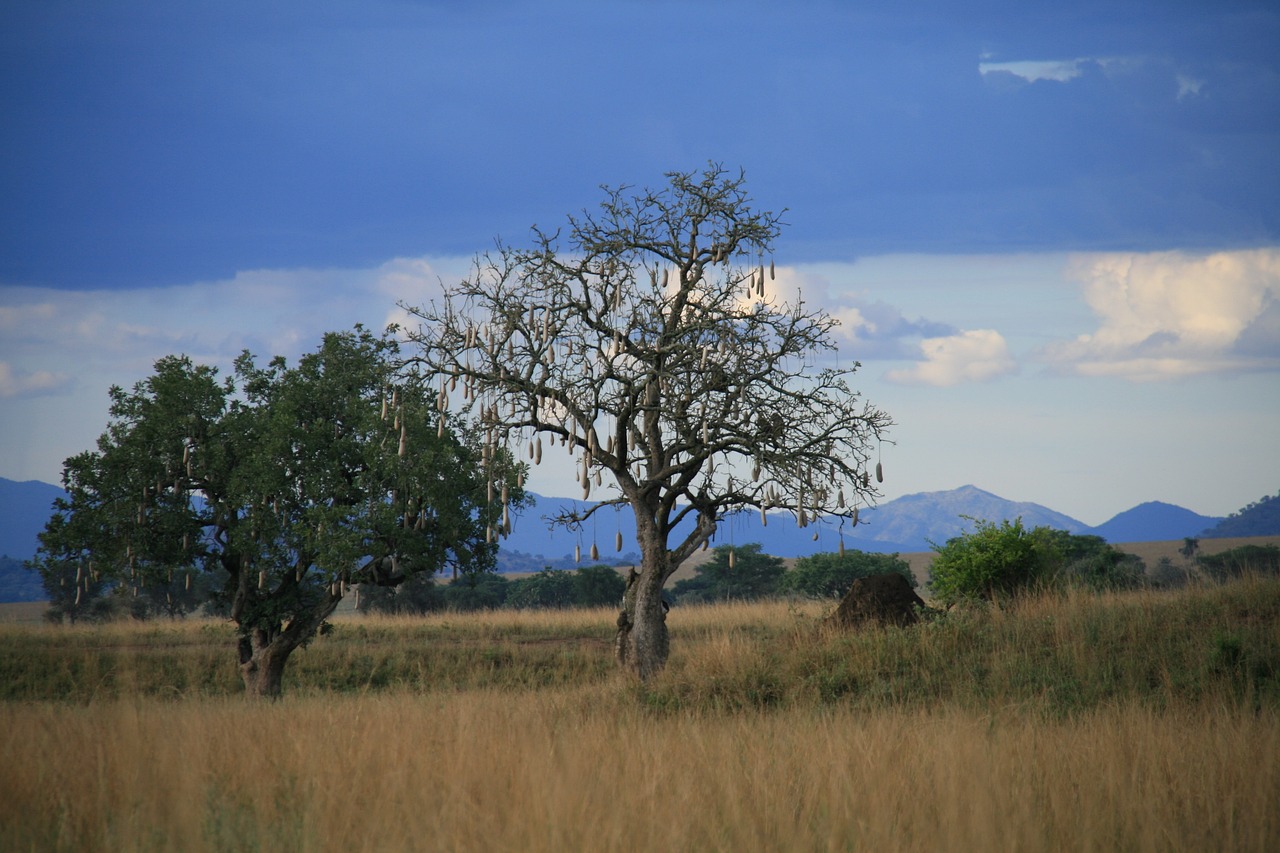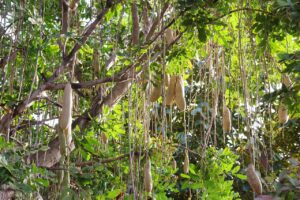Sausage Tree
Overview
The Sausage Tree, or Kigelia Africana, is notable for its unique fruit that resembles hanging sausages. Thriving in tropical Africa, this versatile tree enjoys sunlight and various soil conditions, growing 20-25 meters tall. Beyond its curious appearance, its leaves offer nutritional value akin to vegetables like spinach. While culturally significant, the tree’s fruit is toxic and should not be consumed. The Sausage Tree blooms attractively at night, inviting pollination by nocturnal bats1 2 3 4 5.

Characteristics
Known for its unique sausage-shaped fruit, cultural significance, and use in traditional remedies despite the fruit’s toxicity.
Region
Tropical Africa, along riverbanks, streams, floodplains, and in open woodland.
Natural Habitat
The Sausage Tree is usually found in the wild on riverbanks, along streams and floodplains, and in open woodland.
Cultivation
Requires full sun exposure, adaptable to various soil types (sandy, clay, loam), and needs good water availability.
Uses and Benefits
The Sausage Tree’s leaves are a nutritional powerhouse, often compared to spinach for their rich nutrient profile2. These leaves are not only a valuable addition to traditional diets but also a testament to the tree’s versatility and cultural significance in African communities3.
While the tree’s distinctive, sausage-shaped fruit may be visually appealing, it is important to exercise caution as they are toxic if consumed4. However, the Sausage Tree’s benefits extend beyond its culinary uses:
- The tree is well-adapted to various environmental conditions, thriving in full sun and tolerating a range of soil types.
- Its night-blooming flowers are a crucial component of the ecosystem, facilitating bat pollination2.
Cultivating the Sausage Tree can be a rewarding experience for nature-conscious gardeners and wildcrafters. By incorporating this unique plant into their gardens, they can enjoy its aesthetic appeal while contributing to the preservation of a species with deep cultural and ecological significance.

Cultivation Tips
Growing a Sausage Tree, or Kigelia Africana, adds a touch of Africa’s wild beauty to your landscape. This impressive tree thrives under full sunshine and is not fussy about soil, making it a good match for sandy, clay, or loam grounds. Give your Sausage Tree plenty of space to reach its full potential, as it can soar to 20-25 meters at maturity1.
The Sausage Tree is water-wise and adapts to its environment. It flourishes with abundant rain but sheds leaves in drier conditions1. Patience is key when growing this unique tree. Flowering begins when the tree is 4 to 6 years old, displaying blooms at night from winter to early summer. These flowers dance with nocturnal bats that pollinate them2.
Enjoy the Sausage Tree’s lush green leaves, but remember:
- The tree’s unique sausage-shaped fruit is not for snacking
- The fruit is poisonous4
With the right conditions and care, your Sausage Tree will thrive and add a distinctive touch to your landscape for years to come.
Seasonal Considerations
The Sausage Tree is a resilient and adaptable plant that thrives in various seasonal conditions. During the rainy season, it flourishes with lush green foliage, taking full advantage of the abundant moisture. However, when faced with drier conditions, this clever tree sheds its leaves to conserve water and energy until the rains return.
As the seasons change, the Sausage Tree’s growth patterns evolve:
- In the winter and early summer, the tree puts on a spectacular display of nocturnal blooms, attracting its faithful pollinator, the bat.
- From late summer to autumn, the tree focuses its energy on developing its distinctive sausage-shaped fruits.
- Throughout the rainy season, the tree’s foliage grows dense and lush, providing shade and beauty to the landscape.
While the Sausage Tree’s unique fruits are a sight to behold, it’s essential to remember that they are poisonous and not suitable for consumption. Enjoy the tree’s seasonal transformations from a safe distance, marveling at its ability to adapt and thrive in diverse conditions.
With proper care and attention to its seasonal needs, the Sausage Tree can be a long-lasting and impressive addition to your garden, growing up to 20-25 meters tall at maturity1. Embrace the changing seasons and appreciate the Sausage Tree’s natural beauty as it evolves throughout the year.

Issues and Troubleshooting
While the Sausage Tree (Kigelia africana) is relatively easy to grow and adaptable to various soil types, there are a few key issues to watch out for:
- Overwatering and poor drainage: The tree can become deciduous in drier conditions, so be mindful not to overwater, and ensure proper drainage to prevent root rot1.
- Pests and diseases: Regularly monitor your Sausage Tree for any signs of pests or disease to catch potential problems early.
During the flowering period from winter to early summer, make sure that night-flying bats, the tree’s natural pollinators, can access the blooms2. This will help ensure successful pollination and fruit development.
Important note: The Sausage Tree’s distinctive fruit is toxic and should be handled with care4.
By staying attentive to these key aspects, you can successfully cultivate and enjoy the unique beauty of the Sausage Tree in your garden.
History and Folklore
The Sausage Tree (Kigelia africana) has been an integral part of African history and folklore for centuries. Its roots run deep along the riverbanks and floodplains, stretching from KwaZulu-Natal to Tanzania5. The tree’s cultural significance is reflected in its various local names, such as ‘umVunguta’ and ‘umFongothi’.
The tree’s most striking feature is its large, pendulous fruit that resembles oversized sausages. This distinctive appearance has inspired not only its common English name but also its Afrikaans and Arabic monikers. In Mozambique, the Bantu people have bestowed upon it the name ‘kigeli-keia’, further emphasizing its importance in their culture.
For generations, African communities have recognized the Sausage Tree as a vital resource, weaving it into the fabric of their daily lives. Its presence has been treasured, and its various uses have been passed down through the ages, cementing its place in the cultural heritage of the continent.
References
1. Gardening Know How. “Sausage Tree Info: How To Grow Kigelia Trees In The Landscape …”, https://www.gardeningknowhow.com/ornamental/trees/kigelia-tree/learn-about-kigelia-sausage-trees.htm
2. San Diego Zoo. “Sausage Tree | San Diego Zoo Animals & Plants”, https://animals.sandiegozoo.org/plants/sausage-tree
3. National Parks Board. “NParks | Kigelia africana – National Parks Board”, https://www.nparks.gov.sg/florafaunaweb/flora/2/9/2980
4. Wikipedia. “Kigelia – Wikipedia”, https://en.wikipedia.org/wiki/Kigelia
5. SANBI. “Kigelia africana | PlantZAfrica – SANBI”, https://pza.sanbi.org/kigelia-africana
Image Credit: SZappi
Image Credit: Juhele
Image Credit: Efraimstochter
Nicolas Duval
Nicolas is a passionate advocate for nature and the art of wildcrafting. His dedication shines through in Wildcraftia, a website he meticulously crafted to serve as a haven for nature enthusiasts worldwide. Driven by a deep appreciation for nature’s connection to humanity, Nicolas embarked on his journey in 2011 with SmokableHerbs, a platform showcasing his love for nature’s bounty. Building upon this foundation, he established Smokably, a thriving online store offering premium herbs and blends to a global audience.
